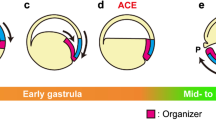Summary
Xenoplastic recombinations of animal and vegetative parts ofAmbystoma mexicanum and Triturus alpestris blastulae, and similar recombinations of parts of3H-thymidinelabelled and unlabelledAmbystoma mexicanum blastulae demonstrate convincingly that the vegetative part (zone IV, see Nieuwkoop, 1969a) of such a recombinate does not contribute to mesoderm formation, but exclusively forms endodermal derivatives. In contrast, the animal cap of the blastula (zones I.II)—which only gives rise to atypical ectoderm if isolated—not only furnishesall the ecto-neurodermal derivatives, butall the mesodermal structures of the developing recombinate as well, and finally to a varying extent forms additional endodermal structures in the recombinate.
In the recombinates endodermization of the ectodermal cap occurred at the anterior end of the invaginated archenteron—corresponding to the presumptive pharyngeal endoderm —, and along the dorsal side of the endodermal tube, while an endoderm-like epithelium is formed at the boundary between the caudal endoderm and the ectoderm (proctodaeum formation). These results suggest that in normal development also endodermization occurs in the “ectodermal half” of the egg. This occurs particularly on the dorsal side, leading to the formation of the presumptive pharyngeal endoderm situated above the dorsal blastoporal groove.
These experiments show that the vegetative “half” of the amphibian blastula is firmly determined as the future endoderm, whereas the animal “half” is still virtually undetermined and pluripotent.
Similar content being viewed by others
References
Chibon, P.: Analyse expérimentale de la régionalisation et des capacités morphogénétiques de la crête neural chez l'amphibien UrodèlePleurodeles waltlii Michah. Mem. Soc. Zool. France36, 1–107 (1966).
Kopriwa, B. M., Leblond, C. P.: Improvements in the coating technique of radioautography. J. Histochem. Cytochem.10, 269–284 (1962).
Motomura, I.: Secretion of microsubstance in the early embryo of an amphibian,Hynobius lichenatus. Sci. Rep. Tôhoku Univ. Ser. IV (Biol.)33, 143–148 (1967).
Nakamura, O., Takasaki, H.: Further studies on the differentiation capacity of the dorsal marginal zone in the morula ofTriturus pyrrhogaster. Proc. Jap. Acad.46, 546–551 (1970a).
— —: Analysis of caudal factors giving rise to the organizer. I. Removal of polar blastomeres from 32 cell embryos ofXenopus laevis Proc. Jap. Acad.47, 499–504 (1971).
— —, Ishihara, M.: Formation of the organizer from combinations of presumptive ectoderm and endoderm. I. Proc. Jap. Acad.47, 313–318 (1971).
— —, Mizohata, T.: Differentiation during cleavage inXenopus laevis. I. Acquisition of self-differentiation capacity of the dorsal marginal zone. Proc. Jap. Acad.46, 694–699 (1970b).
— —, Yamane, H., Obayashi, N., Kôno, S., Okamoto, H., Okumoto, T.: Inductive activity of the organizer in the morula and blastula ofTriturus pyrrhogaster. Proc. Jap. Acad.46, 700–705 (1970c).
Nieuwkoop, P. D.: The formation of the mesoderm in urodelean amphibians. I. Induction by the endoderm. Wilhelm Roux' Archiv162, 341–373 (1969a).
—: The formation of the mesoderm in urodelean amphibians. II. The origin of the dorsoventral polarity of the mesoderm. Wilhelm Roux' Archiv163, 298–315 (1969b).
—: The formation of the mesoderm in urodelean amphibians. III. The vegetalizing action of the Li ion. Wilhelm Roux' Arohiv166, 105–123 (1970).
Rogers, A. W.: Techniques of autoradiography. Amsterdam: Elsevier 1967.
Sudarwati, Sri, Nieuwkoop, P. D.: Mesoderm formation in the anuranXenopus laevis (Daudin). Wilhelm Roux' Archiv166, 189–204 (1971).
Sukirno, Sri Sudarwati: Developmental capacities of the presumptive germ layers of the blastula in the anuranXenopus laevis (Daud.). Thesis, Bandung (1970).
Vogt, W.: Gestaltungsanalyse am Amphibienkeim mit örtlicher Vitalfärbung. II. Gastrulation und Mesodermbildung bei Urodelen und Anuren. Wilhelm Roux' Arch. Entwickl.Mech. Org.120, 384–706 (1929).
Author information
Authors and Affiliations
Rights and permissions
About this article
Cite this article
Nieuwkoop, P.D., Ubbels, G.A. The formation of the mesoderm in urodelean amphibians. W. Roux' Archiv f. Entwicklungsmechanik 169, 185–199 (1972). https://doi.org/10.1007/BF00582552
Received:
Issue Date:
DOI: https://doi.org/10.1007/BF00582552




